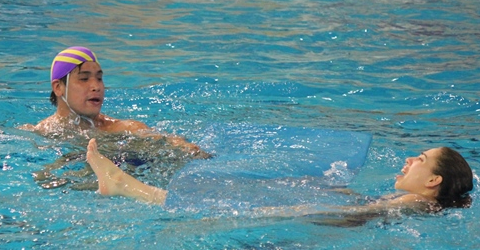
Department
|
Security
|
Approved by:
|
General
Manager
|
|
Reference No.:
|
||||
Section:
|
Security
|
|||
Subject:
|
Rescue progress
|
|||
First Issued by:
|
Chief of Security
|
Date:
|
2016
|
|
Last Revised by:
|
Date:
|
|||
Pages:
|
Attachments:
|
|||
Quy Trình Cứu Hộ Trên
Biển
Sea Rescue Process
When
observing a life-threating situation at sea, our “sea rescue team” will take
immediately action:
-
Inform the Security
Manager
-
Have the nurse on
standby, if necessary call the ambulance
-
Take the lifesaver
Approach
the victim carefully and if the person is responsive speak calmly to the person
Approach the victim carefully and if the person is responsive speak calmly to the person
Keep a safe distance from the victim, push the ring buoy to the victim, hold on the other end of the rope attached to the buoy, pull back to the shore once the victim has grabbed the buoy. .If the person is not responsive you start immediately the rescue according to the rescue movements. If the person is not responsive you start immediately the rescue according to the rescue movements. Raise the victim in a supine position
Keep a safe distance from the victim, push the ring buoy to the victim, hold on the other end of the rope attached to the buoy, pull back to the shore once the victim has grabbed the buoy. .If the person is not responsive you start immediately the rescue according to the rescue movements. If the person is not responsive you start immediately the rescue according to the rescue movements. Raise the victim in a supine position
Raise the victim in
a supine position
Step on the end of the line attached
to the ring buoy
Shout
to get the victim’s attention. Make eye contact and say that you are going to
throw the object now. Tell the victim to grab it. (They might not be able to
hear you or respond to you.) When the victim has grasped the object or the line,
slowly pull him or her to safety, A ring buoy, life jacket, Throw the floating
aid. Toss the float so that it lands within reach of the victim, but do not
strike the victim directly. Take the wind and the current of the water into
consideration before you throw. Let the victim know that you are about to throw
the aid, and that he or she needs to grab the aid.[13]
A
good goal is to throw the ring just past the victim, then pull it to him or her
with the rope.
If
you miss the victim or he or she is unable to grab the aid, pull the line back
or try throwing another device.
If
repeated attempts are unsuccessful, you may need to try another method or swim
to push the device closer to the victim.[14]
- Once reached the beach:
Evaluate the person’s situation.
Depending on the situation of the person
(unconscious,
no heart beat etc.), take the first aid measurements properly.
For safety
reason transport the person to the hospital.
Follow up with
the hospital about the condition.
-
Try to identify
if the person is a guest of the resort.
If yes, contact the persons
traveling with the rescued person, follow up what the guest might
need, sent a fruit basket, if the guest can be released from the hospital, ensure complimentary transfer back to the resort.
If it is not a resort guest, try to find out the identidy, inform police if necessary.
-
At any stage the
GM has to be informed / updated.
-
In case of death:
The resort has to ensure that it will be handled in a very discrete way and
keep the guests / public are kept out of the scene, no information can be
disclosed to any one especially not to the press.
-
The GM and PR
from Six Senses Home Office will define the necessary steps.




